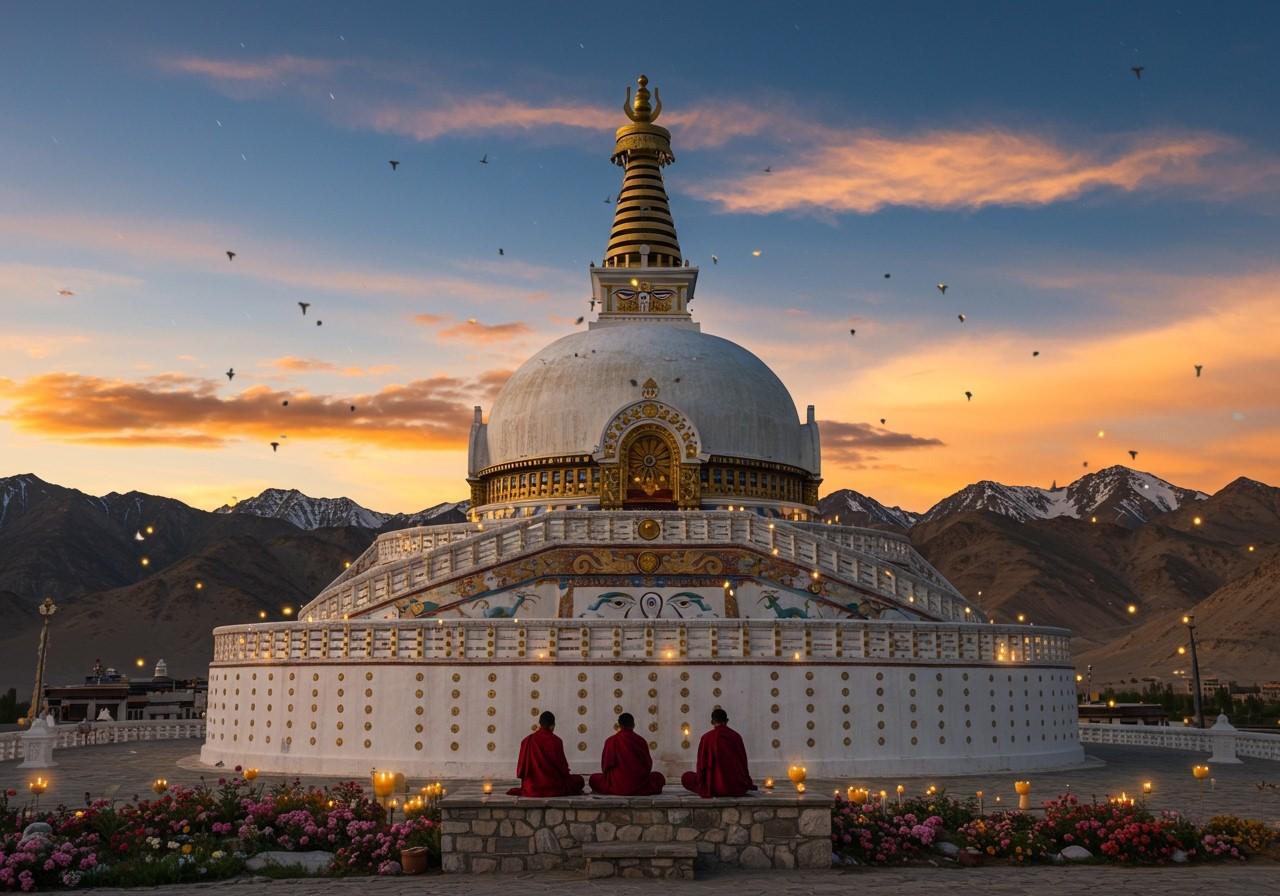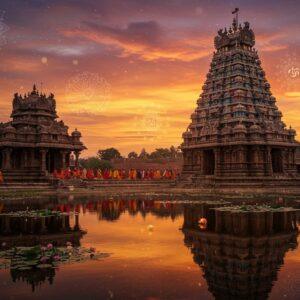
Shanti Stupa stands as an iconic monument in Leh, Ladakh, symbolizing peace and tranquility. As part of the Peace Pagoda mission, it embodies the enduring values of Buddhism and the pursuit of global harmony. This guide offers a comprehensive exploration of Shanti Stupa, its significance, history, and the serene experience it provides.
Historical Significance
Constructed in 1991 by Japanese Buddhist Bhikshu Gyomyo Nakamura and Indian Buddhists, Shanti Stupa promotes world peace and commemorates 2500 years of Buddhism. It fosters Indo-Japanese friendship and cultural exchange. Local Ladakhi and Japanese volunteers collaborated on this magnificent structure. The 14th Dalai Lama enshrined relics of Buddha at its base, imbuing it with spiritual depth. The architecture blends Japanese and Ladakhi styles, creating a unique aesthetic.
Shanti Stupa’s construction has revitalized Buddhism in the region, establishing it as a spiritual center for locals and tourists. It stands as a testament to the enduring power of peace and the shared human aspiration for tranquility.
Architectural Marvel
Shanti Stupa’s stunning white-domed structure symbolizes purity and peace. Intricate carvings and frescoes depict events from Buddha’s life. The two-level stupa features a central relief of Dharmachakra on the lower level and Buddha statues on the upper level. Visitors enjoy panoramic views of the surrounding mountain ranges and the Indus Valley.
At night, the illuminated stupa creates a serene, divine atmosphere. Traditional Ladakhi techniques and materials blend with modern methods. At 3,613 meters, it’s an architectural marvel in Ladakh’s rugged landscape.
Spiritual Experience
Shanti Stupa offers a meditative ambiance for devotees and peace-seeking tourists. Daily rituals and prayers by monks enhance the spiritual environment. Prayer wheels surround the stupa, integral to Buddhist practice. Sunrise and sunset views provide tranquil, reflective moments.
Silence and mindfulness are encouraged, fostering inner connection. Annual Buddhist festivals and ceremonies draw pilgrims worldwide, making it a hub for spiritual growth and introspection.
Visitor Information
Planning a trip to Shanti Stupa requires some practical information:
- Best Time to Visit: Summer (May to September) offers pleasant weather; avoid harsh winters.
- Acclimatization Tips: Due to the high altitude, gradual acclimatization is crucial to prevent altitude sickness. Take it easy on your first day and stay hydrated.
- Accessibility: Reach Shanti Stupa via a well-paved road or a 500-step stairway for a more adventurous approach. Taxis and local transport are readily available.
- Accommodation: Leh offers diverse options, from budget guesthouses to luxury hotels. Booking in advance, especially during peak season, is recommended.
- Local Cuisine: Savor traditional Ladakhi dishes at local eateries in Leh. Try Thukpa, Momos, and Skyu for an authentic culinary experience.
- Guided Tours: Consider guided tours for deeper insights into Shanti Stupa’s history and significance. Local guides can enrich your understanding of the region.
- Cultural Respect: Dress modestly and maintain silence within the stupa. Respect the site’s cultural and spiritual sanctity.
Local Culture and Surroundings
Ladakh’s rich cultural heritage blends Tibetan Buddhism and local traditions. Explore nearby attractions like Leh Palace for a glimpse into the region’s royal past and Hemis Monastery, one of Ladakh’s largest and wealthiest. Leh’s vibrant markets offer traditional handicrafts and souvenirs.
Adventurers can enjoy scenic treks around Shanti Stupa, including the challenging trek to Khardung La. The warm Ladakhi hospitality enhances the charm of this unique destination.
How Poojn.in Enhances Your Spiritual Journey
Poojn.in offers a wide selection of items to support your visit to Shanti Stupa and enhance your Buddhist practices. Our authentic prayer supplies can help create a more meaningful experience at this sacred site. You can find items such as:
- Prayer and Meditation Supplies: Meditation bells and singing bowls, Buddha statues, Prayer wheels, Lotus-shaped offering bowls, LED battery-operated prayer lamps, and more.
- Essential Buddhist Items: Pure copper and brass incense holders, high-quality meditation cushions and mats, traditional prayer beads (mala), pure cotton prayer flags, and natural incense sticks.
All items are carefully sourced and verified for authenticity. We offer secure packaging and delivery across India. Visit Poojn.in or contact our customer service for assistance in selecting the right materials for your spiritual needs.
Conclusion
Visiting Shanti Stupa is more than sightseeing; it’s a journey into peace and spirituality. This iconic Leh monument embodies Buddhist values, promoting harmony and tranquility. Exploring its history, architecture, and spiritual ambiance fosters a deep connection with the serene surroundings. Whether you seek a spiritual retreat or breathtaking views, Shanti Stupa offers a unique experience. Embrace the culture, respect the traditions, and let the peaceful energy guide you towards inner tranquility. Plan your visit and contribute to a legacy of global peace and cultural unity.
FAQs About Shanti Stupa
What is Shanti Stupa? Shanti Stupa is a white-domed Buddhist monument symbolizing peace and harmony, promoting tranquility and reflection.
Why is Shanti Stupa famous? Its stunning architecture, breathtaking location overlooking Leh, and panoramic views make it a popular spot for meditation and spiritual contemplation.
Where is Shanti Stupa located? Shanti Stupa is situated on a hilltop in Leh, Ladakh, India, easily accessible by road.
What is its significance in Buddhism? Shanti Stupa enshrines relics of the Buddha, symbolizing peace, harmony, and the core teachings of Buddhism.
How can I reach Shanti Stupa? Reach it by road from Leh city or via a scenic stairway for a more active approach.
What can I expect to see? Breathtaking views of the surrounding mountains and valleys, along with intricate carvings and statues depicting Buddha’s life.
Is there an entry fee? No, Shanti Stupa is open to all visitors free of charge.
What is the best time to visit? The summer months (May to September) offer the most pleasant weather and clear skies for optimal viewing.


